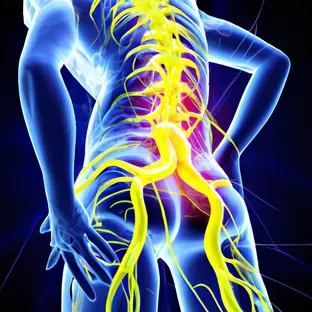What Are Some Effective Treatments For Sciatic Nerve Pain?
Sciatica nerve pain can be debilitating and can significantly reduce quality of life. It is characterized by pain that radiates along the nerve pathway, which runs from the lower back down the back of each leg.
The pain is generally felt in the lower back and/or buttocks, and can sometimes extend down the back of the thigh and even into the foot.
Depending on the severity of your sciatica pain, there are several effective treatments available to help alleviate discomfort and reduce the frequency of flare-ups. In this blog post, we will explore some effective treatments for sciatica.
We will start by looking at non-invasive treatments such as at-home exercises and stretches that may help reduce sciatica pain and improve mobility.
We will also discuss how medications, therapies, and lifestyle changes can help manage and alleviate sciatica pain. Finally, we will discuss when it might be necessary to consider surgical treatment options.
What Are The Symptoms Of Sciatica?
The most common symptoms of sciatica are pain that radiates from the lower back or hip down the back of the leg, numbness or tingling in the leg, and weakness in the leg or foot.
Other symptoms may include pain when sitting, burning or shooting pain, difficulty moving the leg or foot, and a constant pain on one side of the back.
What Is The Sciatic Nerve?
The sciatic nerve is the longest and widest single nerve in the human body. It begins in the lower back and runs through the buttock and down the lower limb, providing innervation to the muscles of the back of the thigh, the lower leg, and the foot.

Physical Therapy To Strengthen Core Muscles
Physical therapy can help reduce sciatic nerve pain by strengthening core muscles. This can help reduce the pain from the sciatic nerve.
The therapist will take into account your medical history, your lifestyle, and any other factors that could impact your sciatic nerve pain.

Physical therapy can help improve mobility, prevent future issues, and even improve your quality of life.
Stretching Exercises To Help Alleviate Tension
Stretching exercises are an important part of any treatment plan for sciatica pain. They help to relieve tension in the lower back, increase flexibility, reduce stiffness, and improve overall body awareness.
To stretch effectively, target the area around the sciatic nerve by performing exercises such as knee to chest stretches, piriformis stretches, and hamstring stretches.
Be sure to stretch slowly and with control, holding each stretch for at least 15-30 seconds. Doing so will help to ensure that your muscles are thoroughly stretched and relaxed.
Ice And Heat Pack To Reduce Inflamation
Heat therapy or ice packs can be effective treatments for sciatica pain. Applying a warm hot pack or a cold ice pack to the affected area can help reduce inflammation and relax the nerve root.
Heat can help relax the muscles and improve circulation in the area, while cold can reduce inflammation and act as a numbing agent for pain.
For best results, alternate between heat and cold, applying each for 10-15 minutes at a time. Be sure to wrap the pack in a thin cloth to protect the skin from direct contact with the heat or ice.
Over-The-Counter Pain Relievers
One of the most common treatments for sciatica pain is over-the-counter pain relievers. NSAIDs, such as ibuprofen and naproxen, are often recommended to help reduce inflammation and relieve pain.
Acetaminophen, such as Tylenol, is also commonly used to provide temporary relief from sciatic nerve pain.
However, it's important to note that these types of pain relievers should not be taken for long periods of time or on a regular basis.
If the pain persists, it's important to talk to a healthcare professional about other treatment options.
Topical Ointments To Reduce Nerve Pain
Topical ointments can be an effective treatment for reducing sciatic nerve pain. These ointments, which are typically applied directly to the skin, contain ingredients such as capsaicin, menthol, and camphor, all of which work together to reduce inflammation and pain.
Additionally, these topical ointments can also reduce nerve sensitivity in the affected area, thus providing temporary relief from sciatic nerve pain.
However, it is important to note that topical ointments should only be used as a short-term treatment and should not be used as a substitute for other forms of treatment.
Electrical Stimulation To Block Pain Signals
Another common treatment option for sciatic nerve pain is electrical stimulation. Electrical stimulation works by delivering small electrical impulses to the affected area.
These impulses interfere with the transmission of pain signals from the nerve to the brain, thereby providing relief from pain.
This type of treatment is non-invasive and can be administered in a clinic or at home. It is typically used in combination with other treatments such as physical therapy, medication, and hot or cold therapy.
Chiropractic Manipulation To Improve Alignment
Chiropractic manipulation is an effective treatment for sciatic nerve pain. It helps improve alignment by applying force to the vertebrae, and can help reduce pressure on the sciatic nerve.
This can help the body heal itself and reduce pain and stiffness in the back and legs. It is important to be aware of the risks associated with this treatment, however, as it can cause strain on the spine and muscles.
For this reason, it is best to have a professional chiropractor perform the treatment.
Acupuncture To Reduce Nerve Inflammation
Acupuncture is an effective treatment for sciatica pain. It involves the insertion of thin needles into specific areas of the body, which stimulates the nerves and reduces inflammation.
A number of studies have demonstrated that acupuncture can be effective in relieving sciatica pain, particularly if combined with other forms of treatment such as medications or physical therapy.
However, the effects of acupuncture may vary from person to person.
Conclusion
Sciatic nerve pain can be a debilitating condition, but there are a variety of effective treatments available to help alleviate the symptoms.
Physical therapy, medications, epidural steroid injections, and chiropractic adjustments are all possible options that may offer relief.
Ultimately, it is important to work with your healthcare professional to find the best treatment plan for your individual needs.
See How to Treat Sciatica Permanently: A Comprehensive Guide
People Also Asked
How is sciatica diagnosed?
Sciatica is most commonly diagnosed through a physical examination. Your doctor may ask questions about your symptoms and medical history, as well as perform a physical exam to check for any physical abnormalities.
Your doctor may also order imaging tests, such as an X-ray, MRI, or CT scan, to further diagnose the condition.
What are the complications of sciatica?
The most common complications of sciatica are pain that lasts or worsens over time, weakness or numbness in the affected leg, loss of bladder or bowel control, difficulty walking or standing, difficulty sleeping, and difficulty performing daily activities.
Muscle atrophy can also occur. Permanent nerve damage can be caused by sciatica.
When is sciatica surgery recommended as a treatment?
Sciatica surgery is typically only recommended when other treatments have failed or when there is a specific condition causing the sciatica that requires surgical intervention. This could include a herniated disc, spinal stenosis, or a tumor that is pressing on the sciatic nerve.
When should I see a doctor about my sciatica?
If you are experiencing any of the following symptoms, it is important to see a doctor as soon as possible:
- Severe or worsening pain
- Pain that radiates down one or both legs
- Pain that interferes with daily activities
- Numbness or weakness in the leg or foot
- Difficulty walking or standing
- Loss of bladder or bowel control



